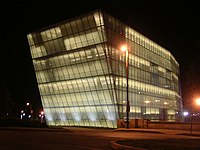Hippodrome Theatre (Baltimore)
 | |||||||||||||||||||||||
 | |||||||||||||||||||||||
| Address | 12 N. Eutaw St. Baltimore, Maryland | ||||||||||||||||||||||
|---|---|---|---|---|---|---|---|---|---|---|---|---|---|---|---|---|---|---|---|---|---|---|---|
| Public transit | University Center/Baltimore Street | ||||||||||||||||||||||
| Owner | Maryland Stadium Authority | ||||||||||||||||||||||
| Operator | Key Brand Entertainment | ||||||||||||||||||||||
| Capacity | 2,300 | ||||||||||||||||||||||
| Construction | |||||||||||||||||||||||
| Opened | 1914 | ||||||||||||||||||||||
| Rebuilt | 2004 | ||||||||||||||||||||||
| Architect | Thomas W. Lamb | ||||||||||||||||||||||
| Website | |||||||||||||||||||||||
| www | |||||||||||||||||||||||
| |||||||||||||||||||||||
The Hippodrome Theatre is a theater in Baltimore, Maryland.
History
Built in 1914 for impresarios Marion Scott Pearce and Scheck, the 2300-seat theater was the foremost vaudeville house in Baltimore, as well as a movie theater. When the movie palace opened, it was the largest theatre in the United States south of Philadelphia.[2] The Hippodrome was designed by Thomas W. Lamb, one of the foremost theater architects of his time. Lamb gave the theater an unusually strong presence on Eutaw Street through the use of brick and terra cotta on a massive façade. The Hippodrome was renovated in 2004 for use as a performing arts theater, and is part of the France-Merrick Performing Arts Center.[3]
The site had previously been occupied by the five story House Hotel, built in 1835 and destroyed by fire on May 25, 1912.[4] The new theater had an original capacity of 3,000 seats and boasted a Moller organ, as well as a house orchestra that survived into the 1950s. The Loew's chain operated the Hippodrome from 1917 to 1924, then Keith-Albee-Orpheum assumed stewardship. In 1920 the average weekly attendance was 30,000. During the 1930s the Hippodrome featured such performers as Jack Benny, Milton Berle, Bob Hope, Martha Raye, Dinah Shore, Red Skelton, The Three Stooges, the Andrews Sisters, Morey Amsterdam, and Benny Goodman. Frank Sinatra first performed with Harry James at the Hippodrome. Live performances ceased in 1959, but movies remained strong through the 1960s. The Hippodrome finally closed in 1990 as the last movie theater in downtown Baltimore.[5]
Renovations

The most recent renovation combined three contiguous existing buildings and a new structure: the Western National Bank Building (1887), the Eutaw Savings Bank Building (1888) and the Hippodrome into a major performing arts complex, designed by Hardy Holzman Pfeiffer Associates. The Maryland Stadium Authority led the renovation.[6] Clear Channel Entertainment (now Live Nation) became the theatre operator after project completion.[7] In 2008, Live Nation sold most of its theatrical assets, including the Hippodrome, to Key Brand Entertainment.[8]
References
- ^ "National Register Information System". National Register of Historic Places. National Park Service. July 9, 2010.
- ^ Theresa Donnelly, “Hippodrome Theatre,” Explore Baltimore Heritage. Retrieved December 26, 2015
- ^ Michael V. Murphy (September 1999). "National Register of Historic Places Registration: The Hippodrome" (PDF). Maryland Historical Trust. Retrieved March 1, 2016.
- ^ Laura Rice. Maryland History In Prints 1743-1900. p. 96.
- ^ "History". The France-Merrick Performing Arts Center. Archived from the original on December 15, 2012. Retrieved February 25, 2014.
- ^ "Hippodrome Performing Arts Center". Maryland Stadium Authority. Retrieved February 25, 2014.
- ^ Dash, Julekha (January 20, 2004). "Clear Channel ready to take over Hippodrome". Baltimore Business Journal. Retrieved February 25, 2014.
- ^ Robertson, Campbell (January 25, 2008). "Live Nation Finds a Buyer for Its Theater Business". The New York Times. Retrieved February 25, 2014.
External links
- The Hippodrome, Baltimore City, including photo in 1998, at Maryland Historical Trust
- The France-Merrick Performing Arts Center
- Hippodrome Theatre at Explore Baltimore Heritage






